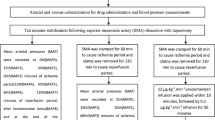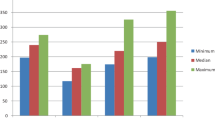Abstract
Background
Intestinal ischemia–reperfusion (I/R) is associated with augmented nitric oxide (NO) production. Increased intra-abdominal pressure (IAP) during surgical pneumoperitoneum (P) facilitates I/R injury. We previously demonstrated decreased strength and healing of colocolic anastomoses after high IAPs. The effect of an NO synthase inhibitor, N G-nitro-arginine methyl ester (l-NAME), on anastomoses realized in colonic tissue exposed to high IAPs was investigated in this study, a randomized, controlled, and experimental study with blind outcome assessment.
Method
Fifty Wistar–albino rats were randomized to five groups; all underwent colocolic anastomosis. P was maintained for 60 min at IAPs of 14, 20, 25, and 30 mmHg in study groups 1, 2, 3, and 4, respectively; P was preceded by intraperitoneal l-NAME (2.5 mg/kg) and followed by anastomosis. The control group was not subjected to IAP or l-NAME.
Results
Anastomosis bursting pressure (ABP) values and histopathological findings were determined on the 7th–14th postoperative days. The ABPs of groups 3–4 were significantly lower than the others. Groups 1–2 had results similar to controls. Histopathological findings of the groups were consistent with their ABPs.
Conclusion
Administration of a 2.5-mg/kg intraperitoneal l-NAME dose was found to provide a beneficial role, implying a role in impaired anastomotic healing after IAPs of 14 and 20 mmHg.

Similar content being viewed by others

References
Schafer M, Sagesser H, Reichen J et al (2001) Alterations in hemodynamics and hepatic and splanchnic circulation during laparoscopy in rats. Surg Endosc 15:1197–1201
Eleftheriadis E, Kotzampassi K, Papanotas K et al (1996) Gut ischemia, oxidative stress and bacterial translocation in elevated abdominal pressure in rats. World J Surg 20:11–16
Eleftheriadis E, Kotzampassi K, Botsios D et al (1996) Splanchnic ischemia during laparoscopic cholecystectomy. Surg Endosc 10:324–326
Caldwell CB, Ricotta JJ (1987) Changes in visceral blood flow with elevated intraabdominal pressure. J Surg Res 43:14–20
Diebel LN, Dulchavsky SA, Wilson RF (1992) Effect of increased intra-abdominal pressure on mesenteric arterial and intestinal mucosal blood flow. J Trauma 33:45–48
Rasmussen IB, Bergren U, Arvidsson D et al (1995) Effects of pneumoperitoneum on splanchnic hemodynamics: an experimental study in pigs. Eur J Surg 161:819–826
Gudmundsson FF, Gislason HG, Dicko A et al (2001) Effects of prolonged increased intra-abdominal pressure on gastrointestinal blood flow in pigs. Surg Endosc 15:854–860
Parks DA, Granger DN (1986) Contributions of ischemia and reperfusion to mucosal lesion formation. Am J Physiol Gastrointest Liver Physiol 250:G749–G753
Polat C, Arikan Y, Vatansev C et al (2002) The effects of increased intraabdominal pressure on colonic anastomoses. Surg Endosc 16:1314–1319
Andrei VE, Schein M, Wise L (1999) Small bowel ischemia following laparoscopic cholecystectomy. Dig Surg 16:522–524
Uen YH, Liang AI, Lee HH (2002) Randomized comparison of conventional carbon dioxide insufflation and abdominal wall lifting for laparoscopic cholecystectomy. J Laparoendosc Adv Surg Tech A 12:7–14
Schoeberg MH, Muhl E, Sellin D et al (1984) Posthypotension generation of superoxide free radicals—possible role in the pathogenesis of the intestinal mucosal damage. Acta Chir Scand 150:301–309
Takada K, Yamashita K, Sakurai-Yamashita Y et al (1998) Participation of nitric oxide in the mucosal injury of rat intestine induced by ischemia reperfusion. J Pharmacol Exp Ther 287:403–407
Beckman JS, Beckman TW, Chen J et al (1990) Apparent hydroxyl radical production by peroxynitrite: implications for endothelial injury from nitric oxide and superoxide. Proc Natl Acad Sci USA 87:1620–1624
Szabo C (1996) The pathophysiological role of peroxynitrite in shock, inflammation, and ischemia–reperfusion injury. Shock 6:79–88
Moncada S, Erusalimsky JD (2002) Does nitric oxide modulate mitochondrial energy generation and apoptosis? Nat Rev Mol Cell Biol 3:214–220
Droge W (2002) Free radicals in the physiological control of cell function. Physiol Rev 82:47–49
Gutteridge JMMC (1995) Lipid peroxidation and antioxidants as biomarkers of tissue damage. Clin Chem 41:1819–1828
Hauet T, Mothes D, Goujon JM et al (1997) Trimetazidine prevents renal injury in the isolated perfused pig kidney exposed to prolonged cold ischemia. Transplantation 64:1082–1086
Förstermann U, Closs EI, Pollock JS et al (1994) Nitric oxide synthase isozymes. Characterization, purification, molecular cloning, and functions. Hypertension 23:1121–1131
Pedoto A, Nandi J, Oler A et al (2001) Role of nitric oxide in acidosis-induced intestinal injury in anesthetized rats. J Lab Clin Med 138:270–276
Boughton-Smith NK, Evans SM, Laszlo F et al (1993) The induction of nitric oxide synthase and intestinal vascular permeability by endotoxin in the rat. Br J Pharmacol 110:1189–1195
Closs EI, Enseleit F, Koesling D et al (1998) Coexpression of inducible NO synthase and soluble guanylyl cyclase in colonic enterocytes: a pathophysiologic signaling pathway for the initiation of diarrhea by gram-negative bacteria. FASEB J 12:1643–1649
Lo CC, Chen JC, Chen HM et al (1999) Aminoguanidine attenuates hemodynamic and microcirculatory derangement in rat intestinal ischemia and reperfusion. J Trauma 47:113–118
Chen JC, Chen HM, Shyr MH et al (2000) Selective inhibition of inducible nitric oxide in ischemia–reperfusion of rat small intestine. J Formos Med Assoc 99:213–218
Förstermann U, Boissel JP, Kleinert H (1998) Expressional control of the ‘constitutive’ isoforms of nitric oxide synthase (NOS I and NOS III). FASEB J 12:773–790
Cuzzocrea S, Zingarelli B, Caputi AP (1998) Role of constitutive nitric oxide synthase and peroxynitrite production in a rat model of splanchnic artery occlusion shock. Life Sci 63:789–799
Qu XW, Rozenfeld RA, Huang W et al (1999) Roles of nitric oxide synthases in platelet-activating factor-induced intestinal necrosis in rats. Crit Care Med 27:356–364
Nowicki JP, Duval D, Poignet H et al (1991) Nitric oxide mediates neuronal death after focal cerebral ischemia in the mouse. Eur J Pharmacol 204:339–340
Kubes P (1993) Ischemia reperfusion in feline small intestine: a role for nitric oxide. Am J Physiol Gastrointest Liver Physiol 262:G143–G149
Luo CC, Chen HM, Chiu CH et al (2001) Effect of N G-nitro-l-arginine methyl ester on intestinal permeability following intestinal ischemia–reperfusion in a rat model. Biol Neonate 80:60–63
Kuluz JW, Prado RJ, Dietrich D et al (1993) The effect of nitric oxide synthase inhibition on infarct volume after reversible focal cerebral ischemia in conscious rats. Stroke 24:2023–2029
Koken T, Inal M (1999) The effect of nitric oxide on ischemia–reperfusion injury in rat liver. Clin Chimica Acta 288:55–62
Erbil Y, Calis A, Berber E et al (2000) The effect of intraoperative colonic lavage with N G-nitro-l-arginine methyl ester (l-NAME) on anastomotic healing in the presence of left sided colonic obstruction in the rat. Surg Today 30:421–425
Author information
Authors and Affiliations
Corresponding author
Rights and permissions
About this article
Cite this article
Polat, C., Arıkan, Y., Gokce, C. et al. The effect of N G-nitro L-arginine methyl ester on colonic anastomosis after increased intra-abdominal pressure. Langenbecks Arch Surg 392, 197–202 (2007). https://doi.org/10.1007/s00423-006-0088-7
Received:
Accepted:
Published:
Issue Date:
DOI: https://doi.org/10.1007/s00423-006-0088-7



